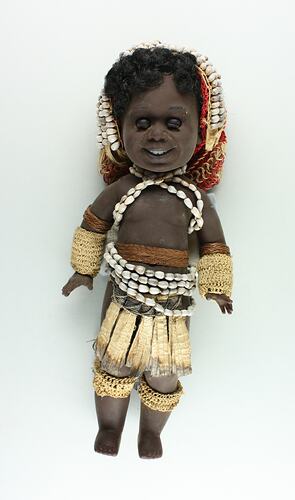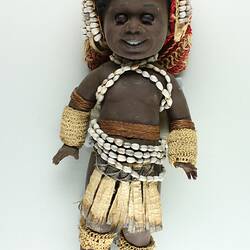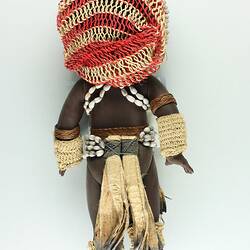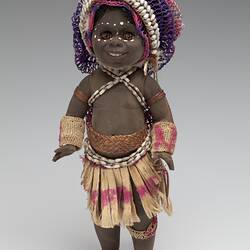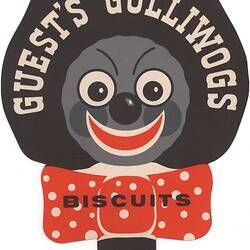Summary
Note: terms such as 'piccaninny' are not condoned by Museums Victoria which considers them to be racist. Historical distance and context do not excuse or erase this fact. This doll is also an example cultural stereotyping for some people.
Vinyl male doll manufactured by South Australian doll company Metti Australia in circa 1970 and decorated by women from Goroka, in the Eastern Highlands Province, Papua New Guinea.
Metti Australia was established in South Australia in 1965 by Richard Hall and Luciano Hall. After recognising a lack of Australian themed dolls, they began producing several First Peoples dolls, designed by Adelaide sculptor Arturo Comelli in consultation with anthropologists at the Adelaide University. These included a girl doll named 'Bindi', as well as a smaller baby version named 'Piccaninny', which were sold in orange cardboard boxes decorated with traditional First Peoples' symbols and artwork. So popular were the dolls that they were produced for over 30 years, even after Metti changed hands and became Netta Australia.
Metti appointed Burns Philp (South Seas) Ltd as its agent in the Pacific Islands. The Bindi and Piccaninny dolls were sold through Burns Philp stores across the Pacific, but modified with darker, curlier hair and darker plastic to approximate Melanesian peoples.
These dolls were bought by many organisations in PNG and used as fundraisers for various organisations including church groups, scouts and women's groups. As part of these fundraisers, villagers, particularly those living in the Highlands, were asked to dress the dolls as authentically as possible in local clothing styles. The dolls were then on-sold as souvenirs, many of them to accompanying PNG scouts on jamborees in Australia and elsewhere, where they were sold to help defray travel costs.
The history of racialised dolls is a complex one. At the time of the production of the Metti dolls there was a problematic and often tokenistic representation of cultures that were often used in a paternalistic way, portraying Indigenous cultures as an exotic curiosity with Metti ostensibly 'possessing' a representation of these people. This and other Metti branded dolls in the collection have another layer of complexity as they were designed with the community in Papua New Guinea with the intent to represent cultural clothing and accessories as accurately as possible. Moreover, such dolls did inject into the toy market more cultural diversity for children; whether this was in the minds of the people producing these dolls is unknown but it is more likely the motivation leant towards selling exotic curiosities.
This example was part of a collection of dolls assembled by English migrant Doreen Wallace, who came to Melbourne by boat in the late 1940s with her husband John. Together they ran Fraser's Toy Shop in Burwood for several years, and many of the dolls came from the shop's stock.
More Information
-
Collecting Areas
Childhood, Migration & Cultural Diversity, Clothing & Textiles, Working Life & Trades
-
Acquisition Information
Donation from John & Doreen Wallace, 30 Sep 2013
-
Manufacturer
Metti Australia, Adelaide, South Australia, Australia, 1968-1970
-
Place & Date Designed
-
Classification
-
Category
-
Discipline
-
Type of item
-
Keywords
Dolls, Toys, Australian Manufacturing Industry, Plastics Industry, Import Tariffs, Cultural Stereotypes, Indigenous Peoples, National Costumes
